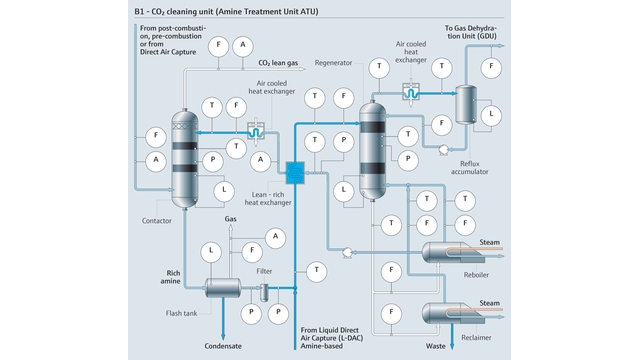Сокращение выбросов углекислого газа с помощью принятия мер по сокращению выбросов УГ в промышленном секторе
Эффективность процессов — ключ к сокращению вредных выбросов в атмосферу. Узнайте больше о новых методах улавливания, использования и хранения CO₂

Углекислый газ в двух словах
- Сокращение выбросов углекислого газа имеет решающее значение для борьбы с глобальным изменением климата. Производители технологических процессов испытывают все большее давление со стороны регулирующих органов, заинтересованных сторон и руководств, стремясь минимизировать выбросы углекислого газа.
- Метод улавливания, использования и хранения углерода (CCUS) — это изменение характеристик углекислого газа. Несмотря на то, что в прошлом этот газ был вреден, сейчас он рассматривается как промышленный ресурс или, по крайней мере, как безвредное вещество во время хранения. Несмотря на то, что технологии CCUS еще только развиваются, они открывают пути для сокращения промышленных выбросов.
- Перед системой CCUS стоит несколько препятствий, включая высокие финансовые затраты, значительные требования касательно используемых энергоресурсов и общественное мнение касательно этого метода. Однако преодоление этих препятствий может уменьшить зависимость от ископаемых видов топлива, а также обеспечить репутационные преимущества для компаний.
- Регулирование со стороны государства, корпоративные цели по снижению выбросов углерода до нулевого уровня, требования цепочки поставок и экологические, социальные и управленческие факторы (ESG) — все это подталкивает промышленные компании к совершенствованию методов по сокращению выбросов УГ.
- Для обеспечения экологически безопасного сокращения выбросов углекислого газа необходимо наладить сотрудничество между правительствами, промышленностью и исследователями для разработки, оптимизации и масштабирования технологий CCUS, а также создать необходимую для этой системы инфраструктуру.
Экологическая необходимость
В связи с необходимостью решения проблемы изменения климата особое внимание уделяется промышленным выбросам углекислого газа во всем мире. Хотя этот парниковый газ необходим для жизни на Земле, его переизбыток в атмосфере, вызванный в основном деятельностью человека, способствует глобальному потеплению.
В результате в промышленности все чаще изучаются возможности смягчения последствий, что обусловлено развивающимися нормативными актами, повышенным вниманием заинтересованных сторон и растущим пониманием того, что экологическая ответственность является этической составляющей ведения бизнеса.
Нормативно-правовая база и факторы, способствующие изменениям
Стремление к снижению выбросов углекислого газа обусловлено желанием человечества приостановить изменение климата. В результате правительства вводят все более строгие правила в отношении процессов с высокой степенью воздействия. В 2015 году 196 сторон ратифицировали Парижское соглашение, в рамках которого была поставлена глобальная цель ограничить потепление до 1,5 °C (34,7 °F) по сравнению с доиндустриальным уровнем. Для поддержания температуры в этом диапазоне потребуется сокращение выбросов ПГ на 45% к 2030 году и множество мероприятий по снижению уровня выбросов УГ до нуля к 2050 году.
Результаты анализа
В 2015 году 196 сторон ратифицировали Парижское соглашение, в рамках которого была поставлена глобальная цель ограничить потепление до 1,5 °C (34,7 °F) по сравнению с доиндустриальным уровнем. Для поддержания температуры в этом диапазоне потребуется сокращение выбросовпарниковых газов на 45% к 2030 году, а также множество мероприятий по снижению уровня выбросов УГ до нуля к 2050 году.
Для поддержки этих общемировых целей формируются региональные законы, устанавливающие цену на углерод, такие как законы США о чистом воздухе и о снижении инфляции, а также Европейское климатическое законодательство и система торговли квотами на выбросы в ЕС. Эти меры обязывают или стимулируют отрасли к сокращению выбросов углекислого газа, заставляя компании учитывать стоимость выбросов в своих бизнес-решениях.
Эра подотчетности заинтересованных сторон
Помимо нормативных требований, на технологии управления выбросами углерода в промышленности обращают внимание и другие факторы, в том числе:
- Корпоративные цели по сокращению выбросов до нулевого уровня: многие компании стремятся соответствовать общемировым целям и ожиданиям заинтересованных сторон, устанавливая амбициозные внутрикорпоративные задачи по сокращению выбросов УГ до нулевого уровня. Для достижения этих рубежей необходимо провести точное измерение, отслеживание и представление данных о выбросах.
- Соответствие цепочек поставок: ведущие компании, стремящиеся к достижению экологически устойчивого развития, предъявляют аналогичные требования к своим цепочкам поставок, требуя от поставщиков демонстрации собственных усилий по сокращению выбросов углерода. Необходимые меры включают определение целей и отчетность по ним, чтобы снизить риск потери ценных деловых партнерств.
- Углеродный рынок: добровольно созданный углеродный рынок является финансовым стимулом для сокращения выбросов углерода, позволяя компаниям компенсировать свои выбросы путем покупки углеродных кредитов, которые финансируют другие проекты по улавливанию углерода.
- ESG: инвесторы все больше осознают финансовые риски, связанные с изменением климата, и некоторые из них требуют прозрачности деятельности и конкретных действий от компаний, в которые они инвестируют. За последнее десятилетие факторы ESG стали более значимыми, и показатели корпоративной устойчивости часто рассматриваются как ключевой показатель долгосрочной стоимости и устойчивости компании. Организации с эффективной стратегией контроля выбросов углекислого газа имеют больше возможностей для привлечения инвестиционного капитала, управления репутационными рисками и получения конкурентных преимуществ в мире, где все больше ценится бережное отношение к окружающей среде.
Технология CCUS для сокращения выбросов и переквалификации CO₂
В отличие от традиционных стратегий, направленных на снижение выбросов, усилия по улавливанию, утилизации и хранению углерода (CCUS) используют другой подход. Их цель — улавливать углекислый газ из крупных точечных источников, затем использовать его для создания ценных продуктов или безопасно хранить, чтобы предотвратить вред окружающей среде от его выброса. Каждый из этих трех компонентов стремительно развивается; регулярно появляются методики, повышающие их эффективность.
Улавливание непосредственно с источника
Процесс улавливания углерода включает в себя удаление CO₂ из отходящих газов технологического потока для предотвращения его выброса в атмосферу. Существуют различные методы их реализации, каждый из которых имеет свои преимущества и трудности и находится на разных стадиях технологической зрелости.
Улавливание после сжигания — наиболее развитый и широко распространенный метод, направленный на улавливание диоксида углерода из дымовых газов, образующихся на электростанциях и промышленных предприятиях после сжигания ископаемого топлива. Амины обычно используются в качестве растворителей для поглощения двуокиси углерода из газового потока.

Хотя этот метод позволяет эффективно улавливать значительную часть углекислого газа, он отличается энергоемкостью, поскольку требует значительного количества тепла для регенерации растворителя амина. Это негативно сказывается на общей эффективности установки и технологического процесса. Если энергия вырабатывается за счет сжигания ископаемого топлива, проблема только усугубляется.
С другой стороны, в ходе процессов улавливания углекислого газа до сжигания он улавливается на стадии, предшествующей сжиганию. В зависимости от концентрации CO₂ можно использовать улавливание на основе аминов или другие технологии.
Превращение отходов в полезные материалы
Утилизационный компонент технологии CCUS дает возможность переквалифицировать уловленный углекислый газ из отхода, предназначенного для хранения, в рыночный продукт.
В качестве примера можно привести метод повышения нефтеотдачи (EOR). Улавливаемый углекислый газ закачивается в истощенные нефтяные и газовые пласты для увеличения добычи нефти и одновременного хранения CO₂ под землей. Однако этот метод требует тщательного мониторинга для снижения потенциальных экологических рисков, связанных с утечкой углекислого газа или индуцированным повышением сейсмичности.
CO₂ также может использоваться в качестве сырья для производства широкого спектра ценных материалов, включая бетон, пластмассы и топливо. Этот подход предлагает надежную альтернативу традиционному производству, основанному на использовании ископаемого топлива. Однако успешность этого проекта зависит от спроса на рынке, снижения затрат и общего воздействия продукта на окружающую среду.
Улавливаемый углерод также может способствовать декарбонизации химической промышленности за счет создания таких ценных продуктов, как полиуретаны. Такой подход к развитию циркулярной экономики является многообещающим, но конкурировать с традиционным производством, основанным на использовании ископаемого топлива, по-прежнему сложно из-за стоимости.
Долгосрочное связывание углерода
Когда углекислый газ нельзя использовать повторно из-за технологических или финансовых ограничений, его следует постоянно хранить под землей, чтобы предотвратить выброс в атмосферу. Наиболее совершенным и широко используемым методом секвестрации углекислого газа является хранение отходов в глубинных геологических формациях. Для этого необходимо закачивать газ глубоко под землю в тщательно отобранные геологические формации. Истощенные нефтяные и газовые резервуары, глубокие соленые водоносные горизонты и соляные купола — вот распространенные варианты для долгосрочного хранения углерода. Эти геологические формации являются обширными и надежными хранилищами благодаря непроницаемым слоям горных пород, которые не позволяют CO₂ выделяться в атмосферу.
Для безопасного и постоянного хранения углерода требуется тщательная оценка местности, современные системы мониторинга и жесткие регулирующие нормы. Эти меры помогают устранить потенциальные риски, такие как утечка углекислого газа, повышение сейсмичности и загрязнение грунтовых вод. Хотя геологическое хранение остается наиболее целесообразным вариантом в обозримом будущем, специалисты в отрасли продолжают изучать альтернативные методы хранения.
Например, карбонизация минералов имитирует естественные геологические процессы, в результате реакции CO₂ с элементами в земле образуются стабильные карбонатные минералы, эффективно удерживающие углерод в течение длительных периодов времени. Хотя долгосрочное хранение обладает большим потенциалом, этот процесс требует значительных затрат энергии и сталкивается с проблемами стоимости, масштабируемости и доступности ресурсов.
Факторы, которые необходимо учитывать
Несмотря на то, что технологии CCUS становится все более перспективным, их широкому распространению по-прежнему препятствуют несколько факторов. Прежде всего, технологии CCUS требуют значительных капиталовложений. Расширение масштабов применения технологий CCUS для существенного воздействия на глобальные выбросы требует общемирового сотрудничества, а также значительных инвестиций в новую инфраструктуру, включая трубопроводы, хранилища и транспортные сети.
Улавливание и сжатие CO₂ требует значительных затрат энергоресурсов, что может свести на нет некоторые преимущества сокращения выбросов. Поэтому повышение энергоэффективности технологий CCUS имеет решающее значение для увеличения общего экологического эффекта.
Кроме того, необходимо решить проблемы, связанные с общественным восприятием технологии CCUS, особенно в отношении возможности утечки углекислого газа через хранение УГ в глубинных геологических формациях. Развитие надежной инфраструктуры и внедрение жестких норм имеют решающее значение для управления рисками, связанными с промышленными выбросами, для завоевания доверия общественности.
Предлагаемые преимущества
Регулирование выбросов CO₂ сопряжено с целым рядом проблем, но бездействие может привести к возникновению еще большего количества препятствий, которые необходимо преодолеть. Являясь парниковым газом, выделяющимся в атмосфере, углекислый газ вносит свой вклад в ухудшение климатических условий. Технологии CCUS предлагают способ устранить или смягчить это воздействие. Несмотря на весь свой потенциал, еще многое предстоит сделать для внедрения эффективных методов сбора и стратегий использования УГ.
Разработка сценариев использования требует постоянного сотрудничества между правительством и отраслями промышленности, но по мере развития технологий регулирования выбросов углерода и получения эффекта масштаба ожидается значительное снижение затрат. Это повысит экономическую целесообразность циркулярной углеродной экономики.
Изучение инновационных технологий, таких как CCUS, оптимизация существующих процессов для повышения энергоэффективности и инвестирование в возобновляемые источники энергии — важнейшие шаги для каждой промышленной компании по сокращению выбросов углерода. Поскольку спрос на низкоуглеродные решения постоянно растет, компании, эффективно регулирующие выбросы углекислого газа, могут получить конкурентное преимущество. Это включает в себя привлечение инвесторов и создание прочной репутации в области устойчивого развития.





